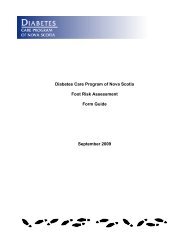CDE Appendix 1 Literature Review - Central East Local Health ...
CDE Appendix 1 Literature Review - Central East Local Health ...
CDE Appendix 1 Literature Review - Central East Local Health ...
Create successful ePaper yourself
Turn your PDF publications into a flip-book with our unique Google optimized e-Paper software.
The Culture, Diversity and Equity Project: <strong>Literature</strong> <strong>Review</strong><br />
This definition has the benefit of explicitly foregrounding the multiple necessary levels of cultural competence<br />
praxis while also accounting for the ongoing, always-in-process nature of becoming culturally competent. The<br />
definition, moreover, informs the (2008) Supportive Housing and Diversity (SHAD) Toolkit and report on culturally<br />
competent best practice for supportive housing provision.<br />
A minority of cultural competence frameworks and definitions have tried to expand the meaning of cultural<br />
competence to more directly address issues and inequities of power. The American College of <strong>Health</strong> Association’s<br />
definition of cultural competence is exemplary in this respect (albeit remaining restricted to an individual-level of<br />
analysis). According to the ACHA:<br />
The term "cultural competency" refers to a long-term, developmental process that moves beyond "cultural<br />
awareness" (the knowledge about a particular group primarily gained through media resources and<br />
workshops) and "cultural sensitivity" (knowledge as well as some level of direct experience with a cultural<br />
group other than one's own). Cultural competency is an engaging, life-long journey of expanding your<br />
horizons, thinking critically about power and oppression, and behaving appropriately. Culturally<br />
competent individuals have a mixture of beliefs/attitudes, knowledge/experience, and skills that help them<br />
to establish trust/rapport and communicate effectively with others (Retrieved 29-01-2009 from<br />
http://www.acha.org/about_acha/culture_comp_alist.cfm; emphasis mine).<br />
This definition also depicts cultural competence as an ongoing process and continuum rather than destination that<br />
can be finally achieved or arrived at once and for all (Anand, 1999; see also Rosenjack Burchum, 2002; Campinha-<br />
Bacote, 1999). The literature contains several organizational developmental models of cultural competence outlining<br />
the evolutionary stages along this continuum (see Jordan, 1998; Wong, 2007; Anand, 1999). The cultural<br />
competence continuum model of Cross et al. (1989) remains the most formative among these.<br />
Another comprehensive definition of cultural competence, in terms of the scope of diversity groups mentioned, is<br />
the Child Welfare League of America’s definition which defines cultural competence as the “ability of individuals<br />
and systems to respond respectfully and effectively to people of all cultures, classes, races, ethnic<br />
backgrounds, sexual orientations, and faiths and religions, in a manner that recognizes, affirms, and values<br />
the worth of individuals, families and communities, and protects and preserves the dignity of each” (cited in<br />
Ontario Ministry of Children and Youth Services 2005 Achieving Cultural Competency). This definition is clearly<br />
articulated within a human rights moral-political idiom and a larger social service context. It is also distinguishable<br />
from most other cultural competence definitions and approaches by its attention to non-ethno-racial dimensions of<br />
cultural difference.<br />
In the clinical and nursing literatures, cultural competence is primarily defined in terms of individual competencies,<br />
attitudes, skills and behaviours (see Campinha-Bacote, 1999; Leininger, 1999; also see Haarmans, 2004 for<br />
summary of this literature). Jirwe et al. (2006), in this respect, describe cultural competence as “the multi-cultural<br />
knowledge base that nurses need, together with the ability to apply such knowledge in practice”. Bush (2000)<br />
likewise defines cultural competency as a “respect for, and understanding of, diverse ethnic and cultural groups,<br />
their histories, traditions, beliefs, and value systems” in the provision and delivery of services.<br />
Leong (1998) further distinguishes between cultural competence and “cross-cultural competence”, defining cultural<br />
competence as “[t]o be able to adapt and function effectively in one’s [own] culture.” (p.3; cited in Haarmans 2004).<br />
Leong makes the argument that what is really at issue in much of the cultural competence literature is “cross-cultural<br />
competence, i.e., the knowledge and skills to relate and communicate effectively with someone from another culture<br />
different from your own” (ibid.). Other theorists and scholars have argued that all encounters are cross-cultural in<br />
nature, due to the multiple axes of culture and difference (e.g. race, gender, class, sexual orientation, religion,<br />
differential abilities etc.) that culturally separate persons from one another in general, and the differing insights and<br />
aptitudes of clinicians and clients, in specific, owing to the formal training and education of the former (Dolhun,<br />
Munoz & Grumbach, 2003; APA, 2002; Tsang & George, 1998; Sue, 2001). Such training, critics suggest, amounts<br />
to a distinctive form of enculturation in itself.<br />
37

















